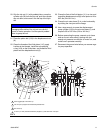
Operation
6 306518ZAC
Operation
Pressure Relief Procedure
Follow the Pressure Relief Procedure whenever
you see this symbol.
1. Close the pump air regulator and bleed-type master
air valve (required in the system).
2. Hold a metal part of the dispensing valve firmly to a
grounded metal waste container and trigger the
valve to relieve the fluid pressure.
Start and Adjusting the Pump
1. With the air regulator (C) closed, open the
bleed-type master air valves (A), or, if so equipped,
join the quick-disconnect coupler (M) to the male fit-
ting (L).
2. Open the dispensing valve (J) into a grounded metal
waste container, making firm metal-to-metal contact
between the container and valve.
3. Open the pump air regulator (C) slowly, just until the
pump is running. When the pump is primed and all
air has been pushed out of the lines, close the dis-
pensing valve.
NOTE: When the pump is, and with sufficient air sup-
plied, the pump starts when the dispensing valve is
opened and shuts off when closed.
4. Adjust the air regulator until you get sufficient flow
from the dispensing valve. Always run the pump at
the lowest pressure necessary to get the desired
results. Do not exceed the maximum working pres-
sure of any component in the system.
5. If your pump accelerates quickly or is running too
fast, stop it immediately and check the fluid supply. If
the supply container is empty and air has been
pumped into the lines, prime the pump and lines
with fluid, or flush it and leave it filled with a compat-
ible solvent. Be sure to eliminate all air from the fluid
lines.
NOTE:
• The low-level cut-off valve accessory (K) closes
the pump fluid intake when the fluid level is low,
which prevents air from entering the system.
• A pump runaway valve (D) should be installed
on the air line to automatically shut off the pump
if it starts to run too fast.
6. Read and follow the instructions supplied with each
component in the system.
7. If the pump will be unattended for any period of
time, if there is an air supply interruption, or at the
end of the work shift, shut off the system and always
relieve the pressure. (See Pressure Relief Proce-
dure)
This equipment stays pressurized until pressure is
manually relieved. To help prevent serious injury from
pressurized fluid, such as skin injection, splashing
fluid and moving parts, follow the Pressure Relief
Procedure when you stop spraying and before
cleaning, checking, or servicing the equipment.
NOTICE
Never allow the pump to run dry of the fluid being
pumped. A dry pump will quickly accelerate to a high
speed, possibly damaging itself, and it may get very
hot.


















